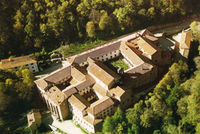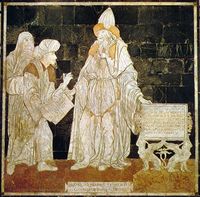Difference between revisions of "Category:Second Temple Studies--1450s"
| Line 1: | Line 1: | ||
{| style="margin-top:10px; background:none;" | |||
| style="background:white; width:65%; border:1px solid #a7d7f9; vertical-align:top; color:#000; padding: 5px 10px 10px 8px; -moz-border-radius: 10px; -webkit-border-radius: 10px; border-radius:10px;" | | |||
<!-- ===================== COLONNA DI SINISTRA ==================== --> | |||
{| cellpadding="2" cellspacing="5" style="width:100%; vertical-align:top; background:transparent;" | |||
{{WindowMain | |||
|title= [[Main Page]] -> [[Second Temple Studies]] | |||
|backgroundLogo= Bluebg_rounded_croped.png | |||
|logo= history.png | |||
|px= 38 | |||
|content= | |||
}} | |||
{{WindowMain | |||
|title= Second Temple Studies in the 1400s | |||
|backgroundLogo= Bluebg_rounded_croped.png | |||
|logo = history.png | |||
|px= 38 | |||
|content= | |||
[[File:Giovanni Pico della Mirandola.jpg|thumb|200px|Giovanni Pico della Mirandola]] | [[File:Giovanni Pico della Mirandola.jpg|thumb|200px|Giovanni Pico della Mirandola]] | ||
[[File:Villa Careggi.jpg|thumb|200px|Villa di Careggi, the headquarter of the Florentine Platonic Academy since 1462]] | [[File:Villa Careggi.jpg|thumb|200px|Villa di Careggi, the headquarter of the Florentine Platonic Academy since 1462]] | ||
| Line 4: | Line 22: | ||
[[File:Hermes Trismegistus.jpg|thumb|200px|Hermes Trismegistus (Cathedral of Siena)]] | [[File:Hermes Trismegistus.jpg|thumb|200px|Hermes Trismegistus (Cathedral of Siena)]] | ||
At the roots of the modern study of "Second Temple Judaism" was the “rediscovery” of Flavius Josephus, that made post-biblical Judaism historically significant, after centuries of oblivion, in the broader context of a renewed interest in Classical Studies. | |||
But it was the movement of the Christian Cabalists and their philosophical search for universal wisdom, that gave theological meaning and dignity to post-biblical Jewish literature. [[Giovanni Pico della Mirandola]] identified the Jewish cabalistic books as the "seventy secret books" preserved by Ezra in addition to the Torah of Moses as claimed by the [[Fourth Book of Ezra]]. Pico viewed these book as a source of philosophical truth that predated the establishment of Judaism, Christianity and Islam and was also at the foundation of the philosophy of the Egyptians and the Greeks. | |||
Pico was a leading member of the Florentine Platonic Academy, that was established by Cosimo de' Medici and Marsilio Ficino, and focused on the study and translation of the Corpus Hermeticum. In Pico's view, there was perfect continuity between Ezra, the wisdom of the Kabbalah and the primeval wisdom of Enoch and Hermes Trismegistos; see [[Enochic Studies]]. | |||
@2014 Gabriele Boccaccini, University of Michigan | |||
}} | |||
|} | |||
|<!-- SPAZI TRA LE COLONNE --> style="border:5px solid transparent;" | | |||
<!-- ===================== COLONNA DI DESTRA ==================== --> | |||
| style="width:35%; border:1px solid #a7d7f9; background:#f5faff; vertical-align:top; padding: 5px 10px 10px 8px; -moz-border-radius: 10px; -webkit-border-radius: 10px; border-radius:10px;"| | |||
{| id="mp-right" cellpadding="2" cellspacing="5" style="width:100%; vertical-align:top; background:#f5faff; background:transparent;" | |||
{{WindowMain | |||
|title= [[Timeline]]: | |||
|backgroundLogo= Bluebg_rounded_croped.png | |||
|logo= history.png | |||
|px= 38 | |||
|content= | |||
}} | |||
{{WindowMain | |||
|title= [[:Category:Second Temple Studies--2010s|2010s (Second Temple)]] | |||
|backgroundLogo= Bluebg_rounded_croped.png | |||
|logo= contents.png | |||
|px= 38 | |||
|content= | |||
}} | |||
{{WindowMain | |||
|title= [[:Category:Second Temple Studies--2000s|2000s (Second Temple)]] | |||
|backgroundLogo= Bluebg_rounded_croped.png | |||
|logo= contents.png | |||
|px= 38 | |||
|content= | |||
}} | |||
{{WindowMain | |||
|title= [[:Category:Second Temple Studies--1990s|1990s (Second Temple)]] | |||
|backgroundLogo= Bluebg_rounded_croped.png | |||
|logo= contents.png | |||
|px= 38 | |||
|content= | |||
}} | |||
{{WindowMain | |||
|title= [[:Category:Second Temple Studies--1980s|1980s (Second Temple)]] | |||
|backgroundLogo= Bluebg_rounded_croped.png | |||
|logo= contents.png | |||
|px= 38 | |||
|content= | |||
}} | |||
{{WindowMain | |||
|title= [[:Category:Second Temple Studies--1970s|1970s (Second Temple)]] | |||
|backgroundLogo= Bluebg_rounded_croped.png | |||
|logo= contents.png | |||
|px= 38 | |||
|content= | |||
}} | |||
{{WindowMain | |||
|title= [[:Category:Second Temple Studies--1960s|1960s (Second Temple)]] | |||
|backgroundLogo= Bluebg_rounded_croped.png | |||
|logo= contents.png | |||
|px= 38 | |||
|content= | |||
}} | |||
{{WindowMain | |||
|title= [[:Category:Second Temple Studies--1950s|1950s (Second Temple)]] | |||
|backgroundLogo= Bluebg_rounded_croped.png | |||
|logo= contents.png | |||
|px= 38 | |||
|content= | |||
}} | |||
{{WindowMain | |||
|title= [[:Category:Second Temple Studies--1940s|1940s (Second Temple)]] | |||
|backgroundLogo= Bluebg_rounded_croped.png | |||
|logo= contents.png | |||
|px= 38 | |||
|content= | |||
}} | |||
{{WindowMain | |||
|title= [[:Category:Second Temple Studies--1930s|1930s (Second Temple)]] | |||
|backgroundLogo= Bluebg_rounded_croped.png | |||
|logo= contents.png | |||
|px= 38 | |||
|content= | |||
}} | |||
{{WindowMain | |||
|title= [[:Category:Second Temple Studies--1920s|1920s (Second Temple)]] | |||
|backgroundLogo= Bluebg_rounded_croped.png | |||
|logo= contents.png | |||
|px= 38 | |||
|content= | |||
}} | |||
{{WindowMain | |||
|title= [[:Category:Second Temple Studies--1910s|1910s (Second Temple)]] | |||
|backgroundLogo= Bluebg_rounded_croped.png | |||
|logo= contents.png | |||
|px= 38 | |||
|content= | |||
}} | |||
{{WindowMain | |||
|title= [[:Category:Second Temple Studies--1900s|1900s (Second Temple)]] | |||
|backgroundLogo= Bluebg_rounded_croped.png | |||
|logo= contents.png | |||
|px= 38 | |||
|content= | |||
}} | |||
{{WindowMain | |||
|title= [[:Category:Second Temple Studies--1850s|1850s (Second Temple)]] | |||
|backgroundLogo= Bluebg_rounded_croped.png | |||
|logo= contents.png | |||
|px= 38 | |||
|content= | |||
}} | |||
{{WindowMain | |||
|title= [[:Category:Second Temple Studies--1800s|1800s (Second Temple)]] | |||
|backgroundLogo= Bluebg_rounded_croped.png | |||
|logo= contents.png | |||
|px= 38 | |||
|content= | |||
}} | |||
{{WindowMain | |||
|title= [[:Category:Second Temple Studies--1700s|1700s (Second Temple)]] | |||
|backgroundLogo= Bluebg_rounded_croped.png | |||
|logo= contents.png | |||
|px= 38 | |||
|content= | |||
}} | |||
{{WindowMain | |||
|title= [[:Category:Second Temple Studies--1600s|1600s (Second Temple)]] | |||
|backgroundLogo= Bluebg_rounded_croped.png | |||
|logo= contents.png | |||
|px= 38 | |||
|content= | |||
}} | |||
== | {{WindowMain | ||
|title= [[:Category:Second Temple Studies--1500s|1500s (Second Temple)]] | |||
|backgroundLogo= Bluebg_rounded_croped.png | |||
|logo= contents.png | |||
|px= 38 | |||
|content= | |||
}} | |||
{{WindowMain | |||
|title= [[:Category:Second Temple Studies--1400s|1400s (Second Temple)]] | |||
|backgroundLogo= Bluebg_rounded_croped.png | |||
|logo= contents.png | |||
|px= 38 | |||
|content= | |||
}} | |||
{{WindowMain | |||
|title= [[:Category:Second Temple Studies--Pre-Modern|Pre-Modern (Second Temple)]] | |||
|backgroundLogo= Bluebg_rounded_croped.png | |||
|logo= contents.png | |||
|px= 38 | |||
|content= | |||
}} | |||
|} | |||
|} | |||
< [[:Category:Second Temple Studies--Pre-Modern|Pre-Modern]] ([[:Category:Second Temple Studies--Top Pre-Modern|Top]]) -- [[:Category:Second Temple Studies--1400s|1400s]] ([[:Category:Second Temple Studies--Top 1400s|Top]]) -- [[:Category:Second Temple Studies--1500s|1500s]] ([[:Category:Second Temple Studies--Top 1500s|Top]]) -- [[:Category:Second Temple Studies--1600s|1600s]] ([[:Category:Second Temple Studies--Top 1600s|Top]]) -- [[:Category:Second Temple Studies--1700s|1700s]] ([[:Category:Second Temple Studies--Top 1700s|Top]]) -- [[:Category:Second Temple Studies--1800s|1800s]] ([[:Category:Second Temple Studies--Top 1800s|Top]]) -- [[:Category:Second Temple Studies--1850s|1850s]] ([[:Category:Second Temple Studies--Top 1850s|Top]]) -- [[:Category:Second Temple Studies--1900s|1900s]] ([[:Category:Second Temple Studies--Top 1900s|Top]]) -- [[:Category:Second Temple Studies--1910s|1910s]] ([[:Category:Second Temple Studies--Top 1910s|Top]]) -- [[:Category:Second Temple Studies--1920s|1920s]] ([[:Category:Second Temple Studies--Top 1920s|Top]]) -- [[:Category:Second Temple Studies--1930s|1930s]] ([[:Category:Second Temple Studies--Top 1930s|Top]]) -- [[:Category:Second Temple Studies--1940s|1940s]] ([[:Category:Second Temple Studies--Top 1940s|Top]]) -- [[:Category:Second Temple Studies--1950s|1950s]] ([[:Category:Second Temple Studies--Top 1950s|Top]]) -- [[:Category:Second Temple Studies--1960s|1960s]] ([[:Category:Second Temple Studies--Top 1960s|Top]]) -- [[:Category:Second Temple Studies--1970s|1970s]] ([[:Category:Second Temple Studies--Top 1970s|Top]]) -- [[:Category:Second Temple Studies--1980s|1980s]] ([[:Category:Second Temple Studies--Top 1980s|Top]]) -- [[:Category:Second Temple Studies--1990s|1990s]] ([[:Category:Second Temple Studies--Top 1990s|Top]]) -- [[:Category:Second Temple Studies--2000s|2000s]] ([[:Category:Second Temple Studies--Top 2000s|Top]]) -- [[:Category:Second Temple Studies--2010s|2010s]] ([[:Category:Second Temple Studies--Top 2010s|Top]]) ... > | |||
Revision as of 10:03, 22 April 2015
|
Second Temple Studies in the 1400s At the roots of the modern study of "Second Temple Judaism" was the “rediscovery” of Flavius Josephus, that made post-biblical Judaism historically significant, after centuries of oblivion, in the broader context of a renewed interest in Classical Studies. But it was the movement of the Christian Cabalists and their philosophical search for universal wisdom, that gave theological meaning and dignity to post-biblical Jewish literature. Giovanni Pico della Mirandola identified the Jewish cabalistic books as the "seventy secret books" preserved by Ezra in addition to the Torah of Moses as claimed by the Fourth Book of Ezra. Pico viewed these book as a source of philosophical truth that predated the establishment of Judaism, Christianity and Islam and was also at the foundation of the philosophy of the Egyptians and the Greeks. Pico was a leading member of the Florentine Platonic Academy, that was established by Cosimo de' Medici and Marsilio Ficino, and focused on the study and translation of the Corpus Hermeticum. In Pico's view, there was perfect continuity between Ezra, the wisdom of the Kabbalah and the primeval wisdom of Enoch and Hermes Trismegistos; see Enochic Studies. @2014 Gabriele Boccaccini, University of Michigan |
|
< Pre-Modern (Top) -- 1400s (Top) -- 1500s (Top) -- 1600s (Top) -- 1700s (Top) -- 1800s (Top) -- 1850s (Top) -- 1900s (Top) -- 1910s (Top) -- 1920s (Top) -- 1930s (Top) -- 1940s (Top) -- 1950s (Top) -- 1960s (Top) -- 1970s (Top) -- 1980s (Top) -- 1990s (Top) -- 2000s (Top) -- 2010s (Top) ... >
Pages in category "Second Temple Studies--1450s"
The following 13 pages are in this category, out of 13 total.
1
- (++) De antiquitate Judaica. De bello Judaico (1470 Schüssler), book (ed. princeps - Latin)
- ספר יוסיפון (Josippon / 1474-76 Conat), book (Hebrew / ed. princeps)
- De antiquitate Judaica. De bello Judaico (1475-76 Brandis), book
- De Bello Judaico (Jewish War / 1475 Sacchi, Pannartz), book
- Storie sacre (Sacred Narratives / 1475c Tornabuoni), poetry
- Josephi opera (1481 Squarciafico), book
- Conclusiones philosophicae, cabalisticae et theologicae (1486 Pico della Mirandola), book
- Oratio de hominis dignitate (Oration on the Dignity of Man / 1486 Pico della Mirandola), book (Latin)
- Josephus de la Bataille Judaique (Josephus's Jewish War / 1492), book
- De bello judaico (Jewish War / 1492 Palencia), book
- Guerra dei Giudei (1493), book



